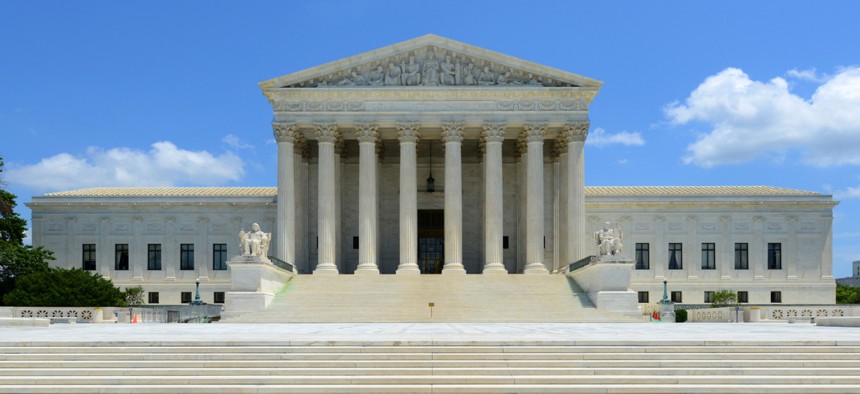Two Years After the Wayfair Decision, State Governments Still Lag on Modernizing Technology Infrastructure to Collect Online Sales Tax Revenue

It's been two years since the Wayfair decision, but states still struggle to collect taxes from online businesses. SHUTTERSHOCK/Wangkun Jia

Connecting state and local government leaders
COMMENTARY | Two years have passed since the landmark Supreme Court decision and the Covid-19 pandemic has put more emphasis on online sales tax revenue than ever before. As states grapple with budget shortfalls, leaders will need to carefully consider how technology is used to ensure that no tax revenue goes unaccounted for.
This month marks the two-year anniversary of the landmark U.S. Supreme Court decision in South Dakota v. Wayfair, Inc., which granted state governments the ability to compel online businesses to collect sales tax for internet-based transactions. In the tax world, this is known as “economic nexus” which means that states have the right to collect taxes on online businesses that aren’t physically present but generate economic activity within the state. Over the past two years, more than 40 states and the District of Columbia have implemented economic nexus laws and started imposing sales tax on remote sellers. While the Wayfair decision has been financially beneficial for some states, with tax revenues increasing by millions of dollars, the onset of the global Covid-19 pandemic has redefined just how critical this revenue is to states.
Stay-at-home orders and the closure of non-essential businesses have significantly reduced the amount of sales tax revenue states have been able to collect from traditional brick-and-mortar retailers and businesses. However, states that have implemented economic nexus laws have had a steady stream of revenue from sales taxes as internet shopping grew over the last few months. While the ability to collect sales tax from online sales is proving to be a saving grace for many state budgets at this time, it also has placed a new burden on states to manage the increased volume of new taxpayers and their returns and payments that cannot be overlooked.
Historically, most states’ approach to tax collection was centered on interacting with taxpayers individually. As a result, state governments built their tax collection processes and IT infrastructure to serve a personalized cadence. Unfortunately, that structure wasn’t always adaptable to changes in the volume of registrations and returns.
Similarly, the number of new businesses collecting and remitting sales tax means states must hold thousands more online businesses accountable to ensure they are collecting all the tax owed. But states had limited capacity before Wayfair to conduct audits and have even less so now.
Ultimately, state officials need a new approach to tax collection to ensure they are maximizing the opportunities afforded by the Wayfair decision, especially as many businesses increase their internet transactions in the Covid-19 era. The first place to start is by reforming the state tax collection technology infrastructure. When determining what technology to employ, states must consider solutions that can efficiently handle large volumes of tax returns in a way that helps them keep better track of businesses and provides more timely information.Many states are slowly modernizing by implementing systems that offer data mining, data warehousing, or predictive analysis capabilities. While these tools help states find unlicensed businesses, they do nothing to help those businesses comply with state law.
With more businesses automating and outsourcing their sales tax compliance in recent years, states can take advantage of the same practice and technology to streamline tax collection. Twenty-five states have enlisted the help of outside companies to leverage the tax automation software and services provided by technology companies known as Certified Service Providers (CSPs). These companies provide tax technology services to businesses. CSP technology automatically processes the calculation and submits returns and payments on behalf of those businesses to the state. The technology provided by CSPs ensures that businesses are able to remain compliant with state laws, while reducing the number of unlicensed businesses that states must track.
Modernizing technology solutions not only gives states a more accurate accounting of sales tax it also gives them the opportunity to see more transaction data and to see it in near real time. It’s only a matter of time before states recognize that receiving sales transactions in real time means they can conduct audits in real time.
Traditional audits are time consuming, intrusive and paper-based. If the point of an audit is to correct errors, then a traditional audit is inefficient because they focus on mistakes made years in the past. Using a CSP allows a state to look at transactions immediately after they happen, or as often as it suits them, which allows the state to correct errors quickly and create a much more accurate accounting of sales taxes. States have experienced difficulty in the past getting in place the necessary tools to conduct near real-time tax accounting because of the severe physical and software requirements on merchants, credit card processors, and the states themselves. But, technology systems like CSP can be implemented without these difficulties.
Making changes like this will go a long way to position states to more readily and cost-effectively scale their tax collection methods. Additionally, it will improve their accountability efforts as they will have a better way of identifying businesses that may not be in compliance with the law, especially as more businesses turn to online retail amidst the global pandemic.
In the increasingly complex world of U.S. sales tax, modernized state technologies are the only way to simplify both the collections process. If not, states risk languishing in a 20th century taxation system that could cost them billions.
Scott Peterson is vice president of U.S. tax policy and government relations at Avalara. Scott spent 10 years as director of the South Dakota Sales Tax Division and 12 years providing research and legal writing for the South Dakota Legislature.

NEXT STORY: San Francisco Voters to Decide on Taxing Companies With Outsized Executive Pay




